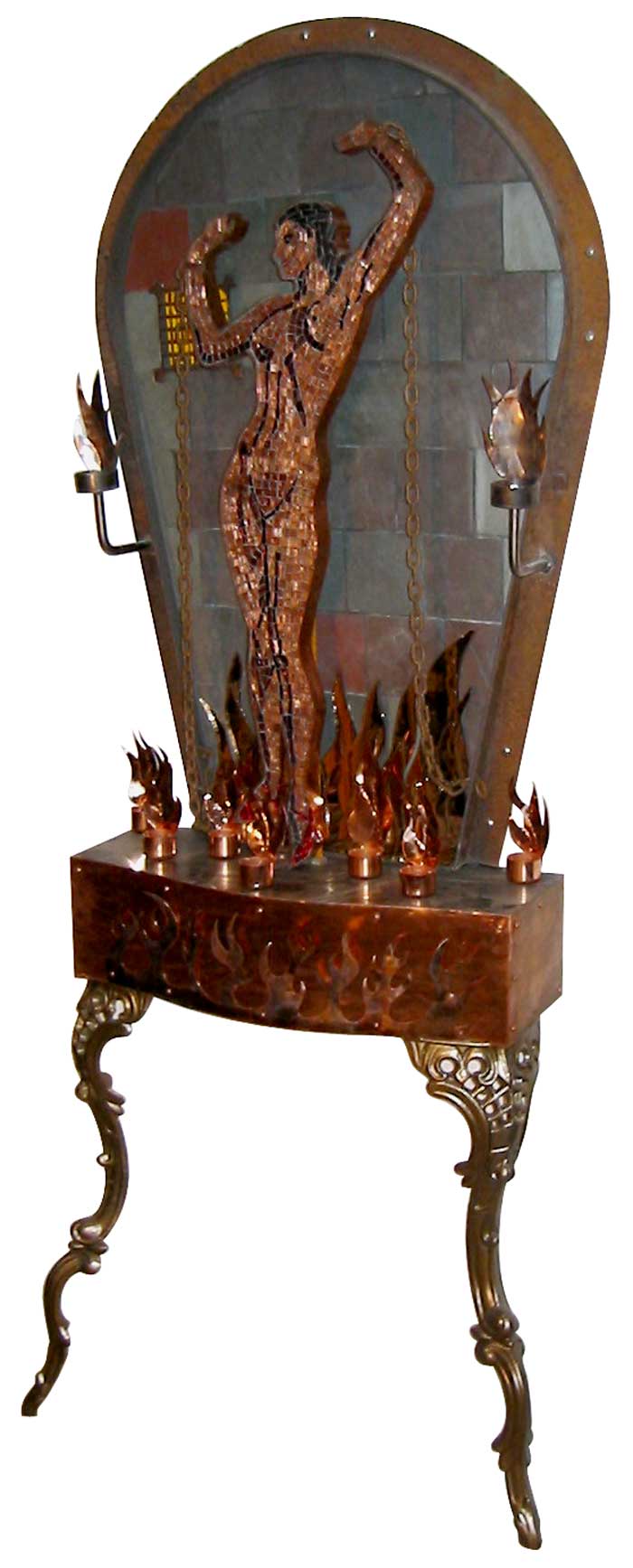25 Sep Altar for Anima Sola and Marinette
Anima Sola/Marinette Altar, 2004
Steel, cast iron, vitreous glass mosaic, slate,
antique mirror, copper, bronze
76″ H x 31″ W x 10″ D
Private collection
I’ve always wanted to do a mosaic of the image of Anima Sola, or “The Lost Soul.” It’s such a powerful image… When my friend Marilyn Houlberg told me she was organizing a museum show focusing on Marinette, Anima Sola’s Haitian counterpart, I started thinking more deeply about how I might do a piece for the show. The conversation got me really jazzed about the idea again, and I realized that not only did the piece not have to be a solid mosaic wall panel, but in fact, it could be so much better if I did it as a mixed media piece.
Anima Sola + Marinette
The Anima Sola or Lonely Soul is a Catholic holy image which depicts a person chained in the flames of Purgatory. The subject is nearly always female, though one does see men occasionally, most often in Mexican retablo paintings. Purgatory, itself, the way station on the road to Heaven where sinners must work off their sins before being admitted to the Pearly Gates, is generally depicted as a stone prison with barred doors and iron grates on the window. Sometimes, it is merely rendered as a smoky haze.
Like many holy images, this one is ambiguous…while it appears to be a very dark image, glorifying suffering and bondage, it is typically seen as an image of redemption. Purgatory, despite it’s unpleasantness is, after all, a place of purification—where sinners are allowed to redeem themselves rather than face the final and permanent fires of Hell. In the traditional images of Anima Sola, the woman wear a transcendant expression and her chains are broken, suggestion that perhaps her time of forgiveness and ascension are at hand. Thus the image is often used to pray for the souls of the dead, that they might enter Heaven more surely and quickly with the intervention of the Anima Sola.
But there is also a darker side to the image…one may also request of Anima Sola that she emprison an enemy in flames of suffering, or whisk them off to Purgatory.
In Haiti, where Catholic images are frequently used to stand in for the Vodoun gods (known as Loa) the image of Anima Sola represents Marinette, the principal female Loa of the Petro rite. Marinette gained much popularity on the eve of the 200th aniversary of the Haitian revolution in 2003. In part, this is because Marinette came from the spirit of the Mambo who conducted the pig sacrifice at the ceremony at Bwa Caiman in 1884 which kicked off the Haitian slave revolution and led to the first independent black republic in the Western Hemisphere. Her current popularity also stems from a dual nature not unlike that of Anima Sola although, Marinette is known to be quite bloodthirsty and violent, she is also capable of interceeding to bring about freedom from bondage or suffering, a freedom Haiti is desparately trying to reclaim.



